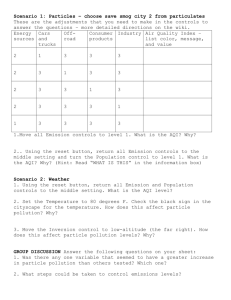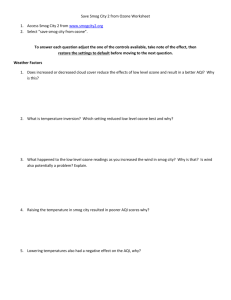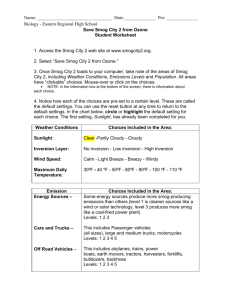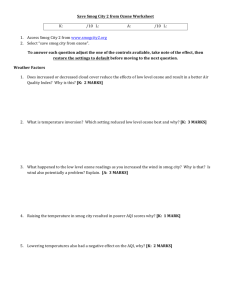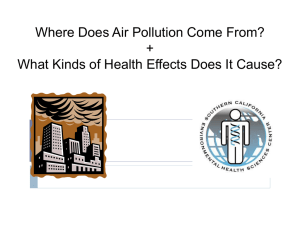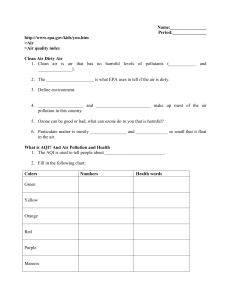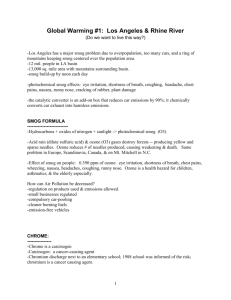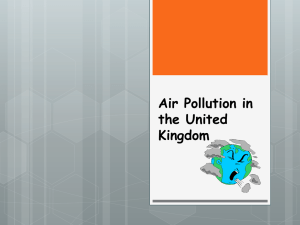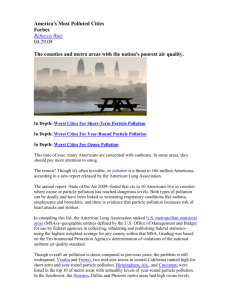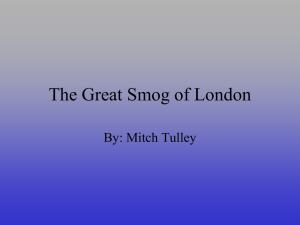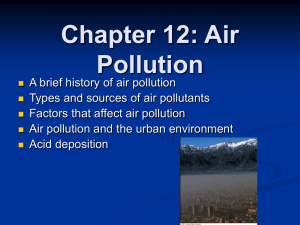Grade Level/Subject
advertisement
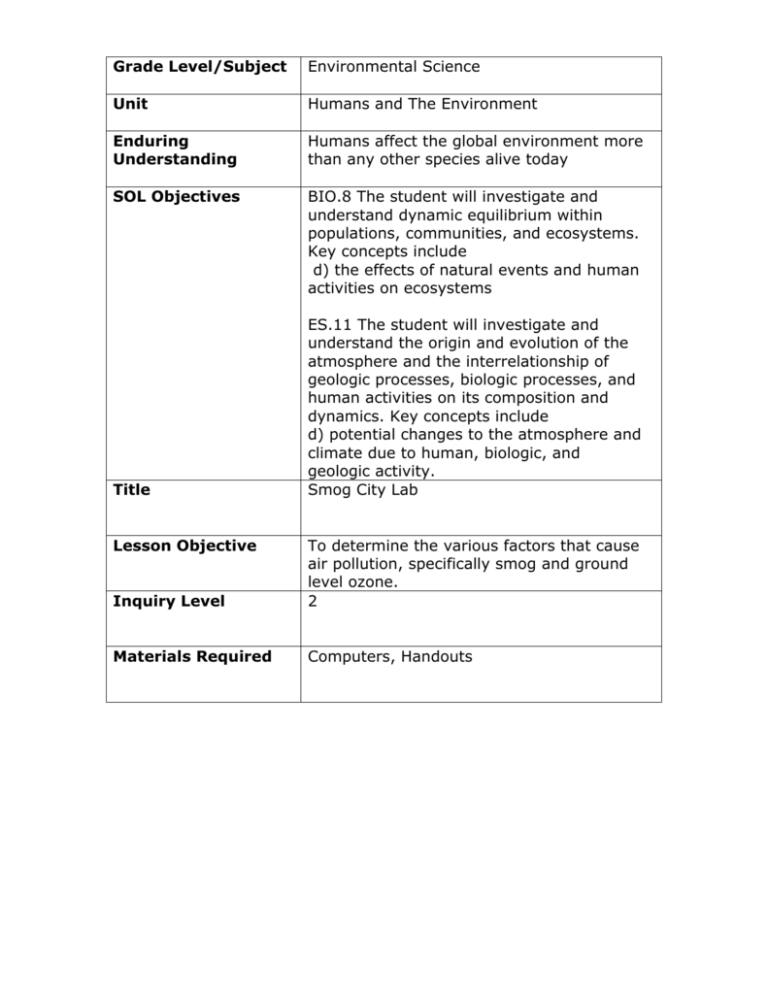
Grade Level/Subject Environmental Science Unit Humans and The Environment Enduring Understanding Humans affect the global environment more than any other species alive today SOL Objectives BIO.8 The student will investigate and understand dynamic equilibrium within populations, communities, and ecosystems. Key concepts include d) the effects of natural events and human activities on ecosystems Title Lesson Objective ES.11 The student will investigate and understand the origin and evolution of the atmosphere and the interrelationship of geologic processes, biologic processes, and human activities on its composition and dynamics. Key concepts include d) potential changes to the atmosphere and climate due to human, biologic, and geologic activity. Smog City Lab Inquiry Level To determine the various factors that cause air pollution, specifically smog and ground level ozone. 2 Materials Required Computers, Handouts Name: ___________________________________________ Date: _____________ Block: ______ Score: _____ / 10pts Save Smog City 2 Particle and Ozone Air Pollution Go to: http://www.smogcity2.com/index.html DIRECTIONS: Activity: Save Smog City 2 from Particle Pollution 1. Select “Save Smog City 2 from Particle Pollution.” 2. Once Smog City 2 loads to your computer, take note of the areas of Smog City, including Weather Conditions, Emissions Levels and Population. All areas have “clickable” choices. Mouse-over or click on the choices. • NOTE: in the information box at the bottom of the screen, there is information about each choice. 3. Notice how each of the choices are pre-set to a certain level. These are called the default settings. You can use the reset button at any time to return to the default settings. Some energy sources produce more smog-producing emissions than others.(level 1 is cleaner sources like a wind or solar technology, level 3 produces more smog like a coal-fired power plant). Passenger vehicles include (all sizes), large and medium trucks, motorcycles. Off road vehicles include airplanes, trains, power boats, earth movers, tractors, harvesters, forklifts, bulldozers, backhoes. Consumer products include paint thinner, charcoal lighter fluid, glue or other adhesives, gasoline. Industry includes manufacturing facilities, power plants, oil refineries/storage/distribution centers, food and agricultural processing. Population – Population in Smog City 2 affects air quality. Changing population, as shown by the “total emissions” chart and the emission sources in the cityscape, affects VOCs, NOx and SO2. The compounds react to form groundlevel ozone and particle pollution. When temperatures are cool, changing population also changes the usage of wood-burning stoves, which emit particle pollution. In Smog City 2, you can increase the population from nearzero to about two million people. 4. Observe the AQI (Air Quality Index) box in the lower right corner. The default settings result in a “red”, or “Unhealthy” AQI for particle pollution. The health message is: “Active children and adults, and people with respiratory disease, such as asthma, should avoid prolonged outdoor exertion; everyone else, especially children, should limit prolonged outdoor exertion.” IN THIS ACTIVITY YOU WILL ADJUST THE WEATHER AND EMMISIONS CONTROLS TO SEE HOW THEY AFFECT THE AIR QUALITY IN SMOG CITY. HYPOTHESES: 1. Which emissions source do you think will have the greatest effect on air quality? 2. Do you think air quality is better in hot, mild, or cold weather? Do you think air quality is better on sunny or cloudy days? DATA: Scenario 1: Particles – choose save smog city 2 from particulates. Fill in the table below. These are the adjustments that you need to make in the controls to answer the questions Energy Cars and Off-road Consumer Industry Air Quality Index – list color, sources trucks products message, and value 2 1 3 3 3 2 3 1 3 3 2 3 3 1 3 2 3 3 3 1 1 3 3 3 3 1. Move all Emission controls to level 1. What is the AQI? Why? 2. Using the reset button, return all Emission controls to the middle setting and turn the Population control to level 1. What is the AQI? Why? (Hint: Read “WHAT IS THIS” in the information box) Scenario 2: Weather and Particulates 1. Using the reset button, return all Emission and Population controls to the middle setting. What is the AQI level? 2. Set the Temperature to 80 degrees F. Check the black sign in the cityscape for the temperature. How does this affect particle pollution? Why? (Look in the information box) 3. Move the Inversion control to low-altitude (the far right). How does this affect particle pollution levels? Why? (Look in the information box) 4. What causes temperature inversions? (look this up online) DISCUSSION QUESTIONS Answer the following questions on your sheet: 1. Was there any one variable that seemed to have a greater increase in particle pollution than others tested? Which one? 2. What are 2 ways we can reduce particle pollution levels? Scenario 3: Ozone – choose save smog city 2 from ozone Energy Cars and Off-road Consumer sources trucks products Industry 2 1 3 3 3 2 4 1 3 3 2 4 3 1 3 2 4 3 3 1 1 4 3 3 3 Air Quality Index – list color, message, and value 1. Turn all Emission controls to level 1. What is the AQI? Why? 2.. Using the reset button, return all Emission controls to the middle setting and turn the Population control to level 1. What is the AQI? Why? (Hint: Read “WHAT IS THIS” in the information box) Scenario 5: Weather and Ozone 1. Set the Temperature to 110 degrees F. Check the black sign in the cityscape for the temperature. How does this affect the AQI? Why? (Look in the information box) 2. Move the cloud cover to cloudy (level 3). How does sunlight affect ozone formation? Why? (Look in the information box) DISCUSSION QUESTIONS: Answer the following questions on your sheet: 1. Where there any variables that seemed to have a greater increase in ozone than others tested? Which one? Explain. 2. What are 2 things that we can do to reduce ozone levels?
